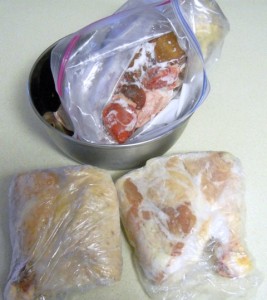Feeding Your German Shepherd Dog, Part 2
Feeding a raw diet can be a confusing venture at first, as there are many different styles of raw diets out there with varying degrees of complexity. Some are unnecessarily complex, while others are dangerously simple and leave out vital components. To help take some confusion out of what to feed, we will provide a few simple guidelines to keep in mind when developing a raw diet. In next week’s blog we will also provide a sampling of what we feed here at German Shepherd Watchdogs, plus a sampling of what various club members at our Schutzhund club feed. A raw diet will offer a unique flexibility in the diet plan that is not found with commercial foods, and this flexibility will allow you to customize this diet to your dog’s particular needs.
Guidelines
1. Any raw diet MUST contain raw meaty bones in some form (whole or ground, but preferably whole to provide jaw-strengthening and teeth-cleaning benefits). Dogs cannot just have raw meat, as this provides a very unbalanced diet. They need the minerals found in bones, particularly calcium. When feeding raw meaty bones, one does not need to add a calcium supplement or bone meal supplement.
2. Raw meaty bones should be just that—raw bones wrapped in lots and lots of meat. This eliminates items like chicken wings and turkey wings, which contain entirely too much bone to be fed on their own. Better choices are chicken leg quarters, bone-in chicken breasts, half-chickens, meaty turkey necks, and so forth. Bones must always, always, always be fed RAW, as cooked bones can splinter.
3. Raw meaty bones should be an appropriate size for your dog. A dog the size of a German Shepherd should be eating larger raw meaty bones like chicken leg quarters, bone-in chicken breasts, or lamb breast or brisket, not itty-bitty chicken necks or chicken wings.
4. Small amounts of organ meats should be included in the diet. Organ meats (liver, kidney, pancreas, spleen, etc.) are packed with necessary vitamins and minerals. Some people feed vegetable matter and supplements to get these vitamins and minerals in the diet, but organ meats offer these in abundance in a more bioavailable form. Simple sources for organ meats include chicken or beef liver (incredibly nutrient dense!), beef kidney, chicken or beef heart, and chicken gizzards (heart and gizzards are more like ‘muscle meat’ in their composition, despite being “organs”). Of all the organ meats, liver is the most nutrient dense and the most important organ to feed; fortunately, it is also easy to find in stores (particularly chicken liver). Introduce small amounts of organ meat slowly, as too much organ meat can cause loose stools.
5. Feed approximately 2-3% of the dog’s IDEAL weight per day. For example, an 85-pound dog should receive approximately 2 pounds of food per day. If a dog is overweight or underweight, feed 2-3% of what the dog’s weight should be. Watch the dog’s body condition and adjust food intake accordingly. When a dog is at their ideal weight, ribs should be easily felt and the last two floating ribs should be visible. There should be a clearly defined waist when viewed from above and from the side. Most pets in the U.S. are overweight, so it is important to familiarize oneself with what ideal weight and body composition looks like.
Next week we will provide sample “menus” of various raw diets. In the meantime, valuable information can be found at these links below:
- ‘Prey Model’ vs. ‘BARF’ diets:
http://rawfed.com/myths/preymodel.html - Looking at the ‘Big Picture’:
http://www.rawlearning.com/bigpicture.html - Raw Fed Dogs–photos and information on feeding raw meaty bones
http://www.rawfeddogs.net
See you next week,
CK


